Beastfolk
Apefolk
Bearfolk – Ursine
Catfolk
Foxfolk – Vulpine
Frogfolk – Bullywug
Frogfolk – Grung
Porcine folk – Varkind
Rabbitfolk – Kunek
Ratfolk
Generic Class options
Beastfolk
Bestial folk can use their bodies in amazing ways, when compared to what most people consider the general bipedal template to be capable of. Some have heightened senses, and others move through obstacles that would challenge someone else with the benefit of daily training. Their origins vary: some are descended from fey in the early verses if the song of creation, and others arose naturally alongside humanity. Some have difficulty integrating into societies; especially where unfounded fear of the lycanthropy hangs over a populace.
“I had probably slain at least a hundred Charau-ka before I first befriended one. Like so many others of my kind, I had long since written them off as unintelligent brutes with little to offer.
But in time, I found them tender with their young- at least until puberty- and their dedication to strength admirable, in its own way. They are survivors.
– Gustavius, Pathfinder extraordinaire
Integration
Most beastfolk prefer living in the wilds with their own kind, but this says more about most folks’ tolerance for their kind than anything at all about the beastfolk. Some beastfolk integrate easily and eagerly into city life, often to the derision of their own kind. Others still use stealth and cunning to mask their nature from intolerant folk.
A few make their presence known only to trade, and then disappear, returning to their own civilizations deep in the wilderness, never lingering in dangerous or prejudiced lands.
Beastfolk Traits
Different types of Bestfolk are extremely diverse, with only the following trais in common.
Beastly Brotherhood
You have Expertise with Animal handling and Intimidation checks when interacting with normal animals related to your kind.
Apefolk
Like 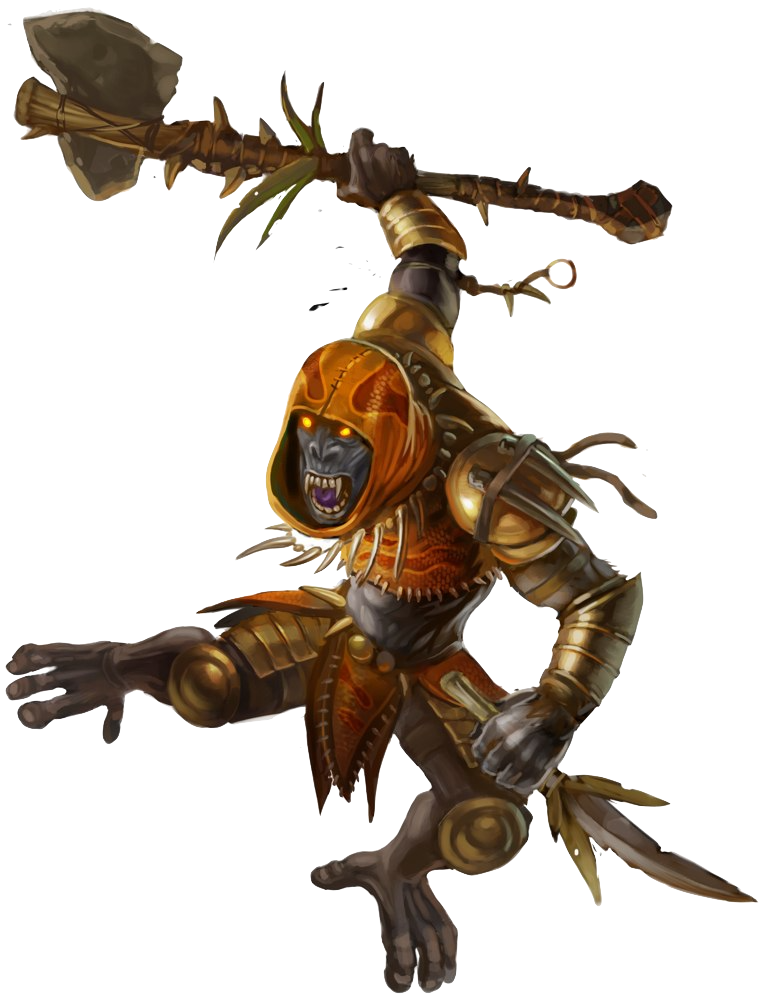 humans, apefolk are varied, clever, and highly adaptable. Those that leave their homes and native jungles behind are rare enough to turn heads when encountered by the unfamiliar, and at first glance, a naked greater ape is almost indistinguishable from their beastly counterparts. This has led to more than a few unfortunate misunderstandings and members of this proud people have been kept imprisoned by charlatans and circuses who show off their talking ape as a curiosity for passing travelers.
humans, apefolk are varied, clever, and highly adaptable. Those that leave their homes and native jungles behind are rare enough to turn heads when encountered by the unfamiliar, and at first glance, a naked greater ape is almost indistinguishable from their beastly counterparts. This has led to more than a few unfortunate misunderstandings and members of this proud people have been kept imprisoned by charlatans and circuses who show off their talking ape as a curiosity for passing travelers.
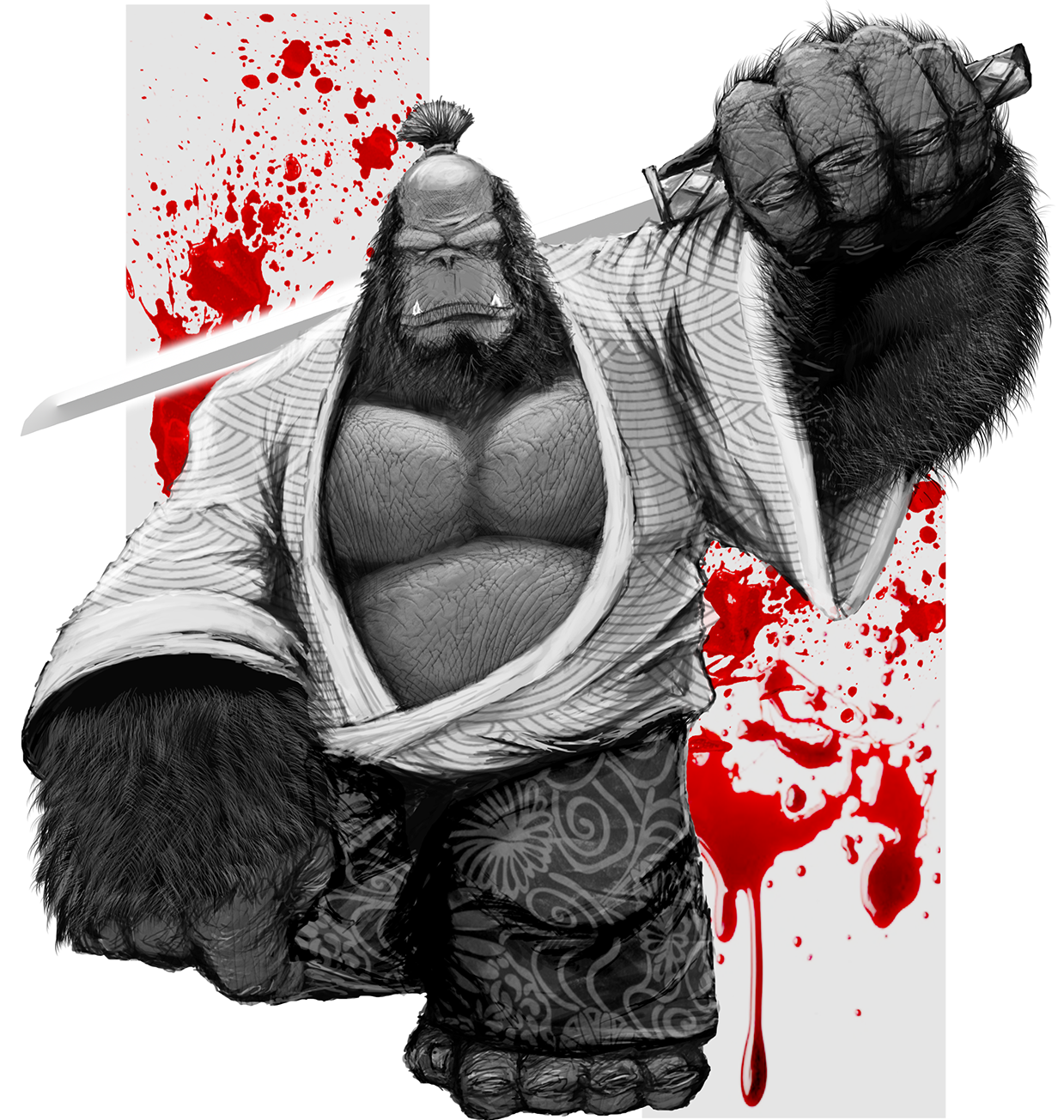
Apefolk tribes are known for their making alliances and readily join ranks with other races, forming long generational bonds. In areas where this has happened, seeing an ape tending bar or serving as a city guard can become a regular sight. Of all other races, apes are the least likely to trust humans, who they often believe themselves superior to in every way.
Apefolk do not live quite as long as their human cousins, and mature and age at more rapid rates. The greater apes are divided into two distinct races: the Ozo and the Charau-ka. The Ozo tend to dedicate themselves to a life of duty and service, while the Charau-ka are more likely to take to a life of freewheeling opportunism.
Traits
Apefolk characters have the following traits in common.
Languages. You can speak Common and Apelong.
Powerful Build. You count as one size larger when determining your carrying capacity and the weight you can push, drag and lift, or when grappling a creature.
Subtype. Different types of Apefolk are available to you. Choose Ozo or Charau-ka listed in the following section.
Ozo
The mighty Ozo tower over their relatively hairless human cousins, preferring to walk on all fours. They usually resemble gorillas or orangutans.
-
Ability Scores. Your Strength ability score, both current and maximum, increases by 2.
-
Age. Ozo mature at 10 years and live up to 60 years.
-
Size. Adult males stand between 1.4 and 1.95 m tall, with an arm span that stretches from 2.3 to 2.7 m. Female Ozo are shorter at 1.25 to 1.5 m. A male Ozo weighs on average 170 kg, but can reach weights of 270 kg. Your size is Medium.
-
Speed. You have a movement speed of 35 ft when your hands are unoccupied, 30 ft when one hand is occupied and 25 ft when both hands are occupied.
-
Ape Weaponry. You can use your teeth or hands to make unarmed strikes. If you hit, you deal bludgeoning (fists) or piercing (bite) damage equal to 1d6 + your Strength modifier.
-
Imposing Stature. Add the Physique skill to your class skills if not already there. The Physique - Intimidation skill costs 0 for you.
-
Woodland Traveler. Difficult terrain due to plants, bushes or trees does not impede your movement.
Charau-ka
Charau-ka resemble chimpanzees, and despite their small stature, are much stronger than they look. Their keen minds lead them to all kinds of professions.
-
Age. Charau-ka mature at 10 and live up to 70 years.
-
Size. Charau-ka stand between 3½ and 4½ feet tall, and weigh 80-130 pounds. Your size is Small.
-
Speed. You have a movement speed of 25 ft and a climbing speed of 20 ft.
-
Ape Weaponry. You can use your teeth or hands to make unarmed strikes. If you hit, you deal bludgeoning (fists) or piercing (bite) damage equal to 1d4 + your Strength modifier.
-
Dexterous Feet. Your feet can serve as a second pair of hands. They can lift a number of pounds equal to five times your Strength score. You can grasp things with your feet, and can use them to do simple tasks like hold objects or open a door or a container.
While holding something with one or both feet, your walking speed is 0. Your climbing speed is halved, unless both your hands are free.
-
Graceful Movement. Add the Acrobatics skill to your class skills if not already there, and gain 1 skill point to spend on that skill. When not wearing heavy armor, you can use your Dexterity in place of your Strength when climbing and determining the distance you can cover when making a jump.
-
Prehensile Tail. You can make object interactions using your tail, and if you are not wearing heavy armor, you can suspend your body weight from it.
Apefolk class options
Apefolk approaches some classes is a bit different than other races. When you select one of these classes, it is modified as described below, as well as described in the general Beastfolk class option chapter.
-
Barbarian
An Ozo raging is a terrifying sight which scares almost everyone in their right mind. When entering rage, all enemies of your size or smaller within 60 ft must succeed at a Wisdom saving throw against a DC 8 + your Strength modifier + your proficiency bonus or become frightened of you.
A frightened creature can repeat the saving throw at the end of each of its turns, ending the effect on a success. Otherwise it lasts until the creature is out of sight or one minute after you exit your rage.
A charau-ka barbarian has access to the Path of the Tailfighter.
-
Cavalier
As one can expect, there are not many ozo cavaliers. They are simply to heavy for most common riding animals. However, it is not impossible. There has been sightings of ozo riding elephants, hippos and even rhinos.
Some charau-ka tribes befriend and ride warthogs or boars, whose sometimes mean-spirited temper and fearlessness makes them ideal for charging into battle.
-
Swashbuckler
Charau-ka are very mobile and the more fearless among them become excellent swashbucklers. Surprisingly enough, this also applies to ozo, escpecially among the smaller specimens.
Whenever the Swashbuckler class description mentions your Intelligence modifier, you may instead use your proficiency bonus.
Ursine
Reclusive but powerful, ursine are humanoid bearfolk that tend to keep to mountain villages, tranquil forests, or the cold tundras & wilderness far from civilization. Although their appearance may scare some off, some races and personalities find their calm and easy-going ways refreshing—an opinion sometimes shaken when an ursine is provoked.
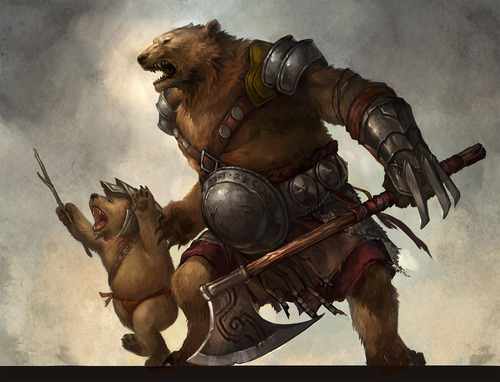
Three Furs
Ursine have been shaped by their environments into three distinct subraces, each having adapted to different conditions and ways of life. Arctic ursine are the largest and sport dense insulating white fur that serves to provide both warmth and camouflage in snowy landscapes, and have narrower skulls than others. Forest ursine are the smallest of the the three, have mostly black fur, and possess claws well-suited to climbing trees in their woodland homes. Brown-furred mountain ursine fall in between the two extremes of size, although they are more bulky than arctic ursine.
Given their thick fur, ursine consider clothing to be entirely optional, most often donning garb only for religious or practical reasons. Armor is another exception, for those that make their living in dangerous professions such as mercenary work.
Legends
There are many different theories about how ursine came to be, and any definite truth is lost to the ages. Some say that ursine were originally werebears cursed by a god, and eventually chose to remain in their bear forms. Others simply say ursine were created along with many of the other races, and are lesser known only because of their isolated lifestyles.
Another legend posits that ursine in fact came first and were chosen by the gods to be shepherds of the wilds and lesser beasts, but that a group of ursine offended the gods in some terrible way. This group was struck dumb, creating the common bears everyone knows today, while the faithful ursine continued on serving the gods as shepherds.
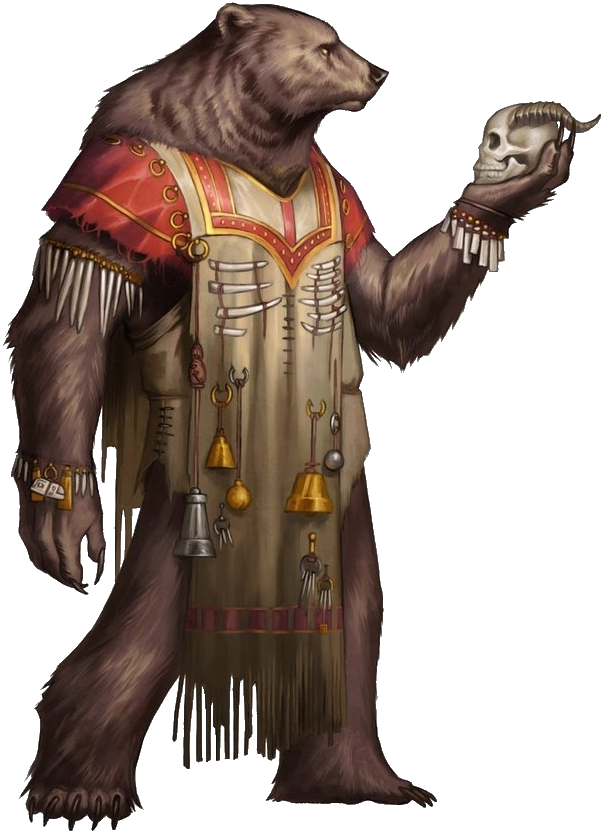
Natural Wanderers
Most ursine tend to live far from civilization, gathering together in villages nestled in the woods, mountains, or tundra, or perhaps living the nomadic life chasing rich hunting grounds or caravan contracts. They usually prefer the quiet of nature, and often find the noise and bustle of cities to be jarring and unwelcome.
This temperament has led many ursine to pursue professions that either keep them on the road or permanently outside towns, such as farmers, hunters, scouts, wilderness guides, caravan guards, sailors, druids, and more.
Ursine don’t mind living in community, however, so long as those communities aren’t large or crowded, and particularly enjoy living in villages or large camps that often consist of a few extended families. Family tends to be important to ursine, although they are not usually clingy—always happy to see each other, no matter how often that might be.
Free spirits, ursine put more value on independence and a wandering soul than tradition, and prize relationships above places or nations. Given the small size of most ursine groups, leaders are usually either de facto or non-existent, with adults or family heads discussing a situation and reaching solution together—or not, in rarer cases, which might result in one family splitting with the group and finding others with which to travel.
Ursine Names
Although there are no strict naming traditions among ursine (particularly as the different subraces often live in quite different environments), there are nonetheless broad trends that have remained consistent throughout the years. Sylvan names associated with nature have always been popular, mostly due to Sylvan being one of the primary languages spoken by ursine.
Male Names: Afon, Bleddyn, Bran, Brynmor, Celyn, Colwyn, Cynwrig, Derwyn, Enfys, Ffionn, Gavin, Glendower, Gwalchmai, Hefin, Idwal, Lloyd
Females Names: Aberfa, Adara, Aelwyd, Alaw, Arthes, Bledig, Blodwen, Briallen, Crisiant, Daron, Efa, Eira, Eleri, Emlyn, Epona, Glenna, Gwen, Gwylan, Hafgan, Jenna, Rhodd, Rowena, Siwan, Talar, Vanora
Surnames: Adar, Awyrlas, Cangengref, Cariadmor, Coedwig, Fryniau, Glanyrafon, Gwynt, Ilaispur, Mellt, Meysydd, Mynydd, Nantclir, Nytheryr, Taenau
Ursine Traits
Ursine character has a number of traits in common.
-
Ability Score Increase. Your Strength ability score, both current and maximum, increases by 2, while your Dexterity ability score, both current and maximum, is reduced by 2.
-
Age. Ursine reach adulthood at around 16 years old, and live approximately as long as humans.
-
Alignment. Ursine vary widely in temperament and have no inborn tendencies toward any specific alignment, and are rather the product of their particular upbringing and surrounding culture.
-
Languages. You know Common and Sylvan.
-
Size. Ursine are bulky creatures, wide-shouldered and standing 1.80 - 3 meters tall, and weighing 100 – 700 kg. Your size is Medium.
-
Speed. Your base speed is 30 ft.
-
Powerful Build. You count as one size larger when determining your carrying capacity and the weight you can push, drag and lift, or when grappling a creature.
-
Rip and Tear. Your unarmed strikes deal 1d6 + your Strength modifier piercing damage (for bite) or slashing damage (for claws). If you have grappled a creature, you may use your bonus action to bite them.
Subtype. There are three related types of ursine, each with their own distinguishing characteristics: arctic ursine, forest ursine, and mountain ursine. Choose one of these subraces.
Arctic Ursine
As an arctic ursine, you’re strong and hardy, able to withstand cold climates and seas as a matter of course. The largest form of the species, arctic ursine usually stand at least 8 and a half feet tall and may weigh up to 1,500 pounds, although the average is closer to 900. Their white fur, resplendent in civilized areas or warmer climates, can provide useful camouflage in the tundras they often call home. These areas do not provide much in the way of permanent shelter, so a nomadic lifestyle is common (a tendency they often maintain even in warmer climes).
-
Ability Score Increase. Your Constitution ability score, both current and maximum, increases by 2, while your Intelligence ability score, both current and maximum, is reduced by 2.
-
Iceborn. Add the Survival skill to your class skills if not already there. The Survival - Arctic skill costs 0 to you. You are naturally adapted to cold climates, as described in chapter 5 of the Dungeon Master’s Guide, and you have resistance to cold damage.
-
Marine Hunter. You have a swimming speed of 20 ft and you can hold your breath for up to 15 minutes at a time.
Forest Ursine
As a forest ursine, you are at home among the trees and traverse them with expertise. The smallest variety of ursine, they typically stand no taller than 8 and a half feet and weigh an average of two to three hundred pounds. Other races often view forest ursine as the most approachable of the three types, a trait that is likely the result of their gentler surroundings. Of all their race, forest ursine are the most likely to have permanent villages and to want to stay near them.
-
Climber. You have a climbing speed of 20 ft.
-
Woodland Adept. You are most at home in forests and woods. Add the Survival skill to your class skills if not already there. The Stealth - Forest and Survival - Forest skills cost 0 for you.
-
Low-light Vision. You have keen senses and can see in dim light within 60 ft of you as if it were bright light.
Mountain Ursine
As a mountain ursine, you embody the fortitude and magical spark of your homeland. Ranging from 7 to 9 feet tall and weighing an average of 500 pounds, brown-furred mountain ursine are known both for their endurance and wisdom. Druids are revered among mountain ursine, as are priests of gods of nature. Although villages of mountain ursine are not uncommon, just as many choose to live their lives on the road or as members of some traveling company or order.
-
Mountain dweller. You are most at home in the mountains. Add the Survival skill to your class skills if not already there. The Survival - Mountain skills cost 0 for you.
-
Ursine Toughness. Your hit point maximum increases by 1, and it increases by 1 every time you gain a level.
-
Unnatural Resilience. You know the resistance cantrip, which you can use on yourself only.
Ursine class options
Ursine approaches some classes is a bit different than other races. When you select one of these classes, it is modified as described below, as well as described in the general Beastfolk class option chapter.
-
Barbarian
An ursine raging is a terrifying sight which scares almost everyone in their right mind. When entering rage, all enemies of your size or smaller within 60 ft must succeed at a Wisdom saving throw against a DC 8 + your Strength modifier + your proficiency bonus or become frightened of you.
A frightened creature can repeat the saving throw at the end of each of its turns, ending the effect on a success. Otherwise it lasts until the creature is out of sight or one minute after you exit your rage.
-
Cavalier
Ursine do not ride, and even if they wanted, no mount would want to carry them.
Catfolk
The small hunter-gatherer tribes of the catfolk roam the plains and forests late into the night, making camp after midnight with easily-portable tents and carpets and sleeping until the afternoon. Rarely settling down for long, they tend to take a passing, but enthusiastic, interest in anything around them and are content to let most things be. Except when they’re not.
The origin of this race is a matter of debate, but the prevalent myth among non-catfolk involves an ancient druid circle’s awaken spell that went haywire and granted a few ordinary creatures a lot more than sapience. They presumably interbred with other normal cats, but the powerful awakening magic in their blood passed on to the offspring and the sentient felines became their own race. The catfolk find the idea that another group of humanoids just created them by mistake a little insulting.
Sleek and Nimble
Catfolk are intelligent bipedal felines, standing from nearly 6 feet tall to just under 5 feet. The exact kind of cat they resemble varies with location, but it is almost always one of the large, predatory types. The environments in which they typically grow up tend to give them at least a slim amount of muscle, and they are naturally agile and quick on their feet. Sometimes catfolk will drop to all fours if they want to make a quick dash, and in a tight situation they will not hesitate to unsheathe the claws embedded in their fingertips.
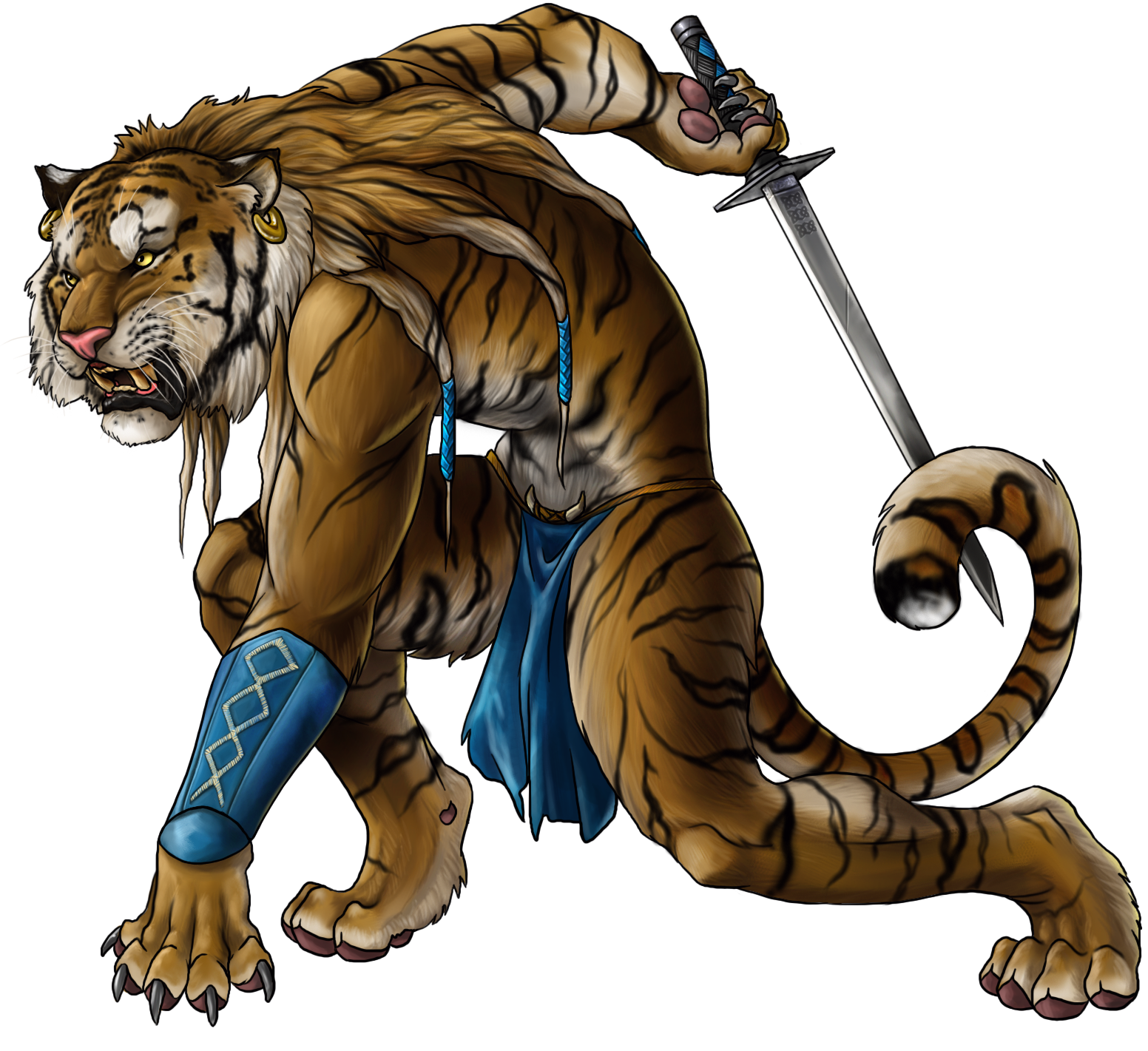
In contrast to these animalistic behaviors, even tribal groups of catfolk put a great deal of importance into how they dress. The felines view stylish clothing as a sign of maturity and sophistication, and make every effort to acquire or fabricate the best garb they can. Fine cloth is especially valuable to the catfolk, and makes a good start for establishing trading relations. They prefer loose clothing that preserves freedom of movement and, due to their large ears and tails, tend to either make it themselves or commission it personally. Nice outfits are passed down through generations like heirlooms, the tears lovingly sewn up and buttons carefully replaced. Because they rarely clothe their young, a small catfolk’s first piece of clothing is a proud sign that they have come of age.
Fleeting Fascinations
If the lifestyles of the humans seem hasty and frenetic to the longer-lived races, the catfolk go through life at a bewildering pace full of short-lived interests. At their most basic levels, the catfolk are highly inquisitive about things which fascinate them, but tend to have short attention spans that keep them from staying dedicated to any one thing for long. Their greater pursuits are anything but single-minded; they often take on several goals at once -all of roughly equal importance - and jump madly back and forth among them. Completing long-term plans is not a catfolk’s typical strong suit.
This behavior extends to their mannerisms, too. Though a catfolk’s overall mood will remain constant, they often contain short, scattered bursts of localized feelings - sudden laughter, brief outrage, and momentary sorrow can all be mixed into an otherwise calm disposition. They don’t hold grudges for very long, and are often surprised if someone they offended one day is still mad at them the next. Similarly, catfolk rarely bother to keep close track of what someone indebted to them owes, and can’t stand sticklers for rules.
Wide Networks, Loosely Connected
Although most catfolk live together in small tribes, they hold no particular loyalty to one or the other. Groups form and break apart just as quickly, and any catfolk might go through being a part of four or five different “tribes” in the course of a year. It’s not uncommon for an individual to just go off on their own, leading a solitary life interspersed with occasionally spending an evening hunting or talking with one group or another as they pass through various territories.
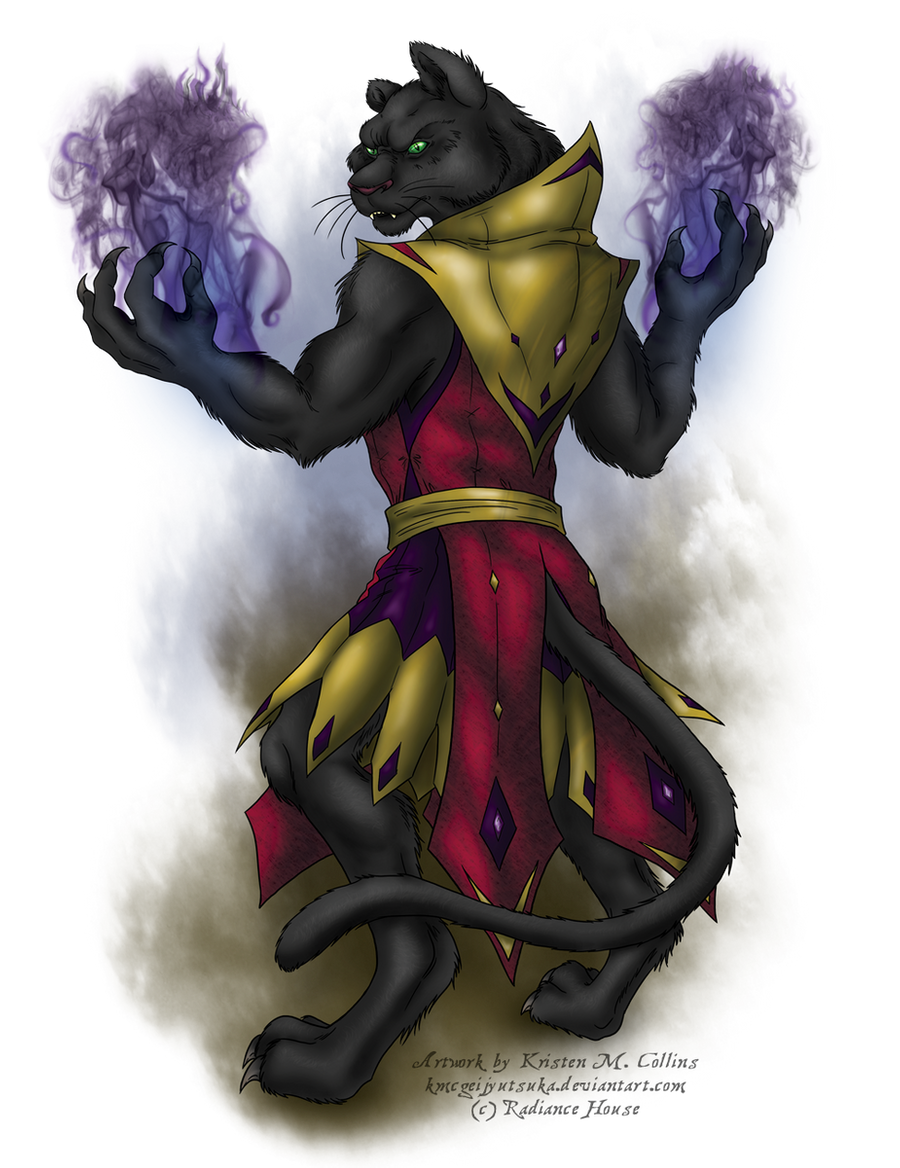
While this sounds chaotic, it actually results in all catfolk in a region having a general idea of what’s going on everywhere else in the region. News spreads quickly through word-of-mouth throughout the community, and the rare catfolk venturing into a city can be a useful source of information from far away, if not a particularly reliable one. They can make decent impromptu messengers across wilderness, too; but again, not particularly reliable ones unless given significant motivation.
Ready Wanderers
The nomadic life of the catfolk makes them particularly suited to the adventurer’s lifestyle, and their typical upbringing makes them fairly well-prepared for one. It doesn’t take much convincing for a passing catfolk to team up with a group of adventurers if their goals sound intriguing, though they can be prone to wandering off on their own from time to time. Catfolk stay loyal to their fellows in spite of this, as the unpredictable nature of quests tends to keep them interested and invested throughout.
Catfolk Names
Catfolk favor names that begin with “D,” “M,” or “N” and contain multiple “s” and “r” sounds. They don’t care about family names as much, and have no qualms about changing them if they join a new tribe or have been spending a lot of time living with another clan. Some adventuring catfolk even abandon having a last name entirely, or make one up.
Male Names: Densharr, Mersharr, Nermissar, Therrass.
Female Names: Dessirris, Mianissa, Morasha, Nera, Thessana.
Clan Names: Flying Eagle, Hunting Tiger, Running Brook, Screaming Arrow
Physical Description
In general, catfolk are lithe and slender. While clearly humanoid, they possess many feline features, including a coat of soft fine fur, slit pupils, and a sleek, slender tail. Their ears are pointed, but unlike those of elves, are more rounded and catlike. They manipulate objects as easily as any other humanoid, but their fingers terminate in small, sharp, retractable claws.
These claws are typically not powerful enough to be used as weapons, but some members of the species—either by quirk of birth or from years of honing—can use them with deadly effect. Feline whiskers are not uncommon, but not universal, and hair and eye color vary greatly.
Catfolk traits
Your catfolk character has a number of traits in common with other catfolk:
-
Ability Scores. Your Dexterity ability score, both current and maximum, increases by 2.
-
Age. Catfolk reach maturity at age 13, but are nearly indistinguishable from ordinary felines for the first decade of their lives, apart from slowly learning to speak. Up until age 10, catfolk children walk on all fours and don’t typically wear clothes, though they steadily grow in size. There are tales about well-meaning humans finding what they presume to be stray kittens and being very surprised when their adopted “pet” started learning to talk.
Around 10 years old, they begin to learn how to stand erect, their bodies grow more humanoid, and they get outfitted for the first time. They have lifespans slightly shorter than humans on average.
-
Alignment. The free-spirited nature of catfolk causes them to tend more towards chaos than law, with no particular inclination for good or evil.
-
Languages. Catfolk speak Common.
-
Size. Catfolk tend to be slightly shorter than most humans, with a more slender, athletic build. Your size is Medium.
-
Speed. Your base speed is 30 ft, but drops to 20 ft if carrying over 50 pounds of weight, regardless of any natural Strength bonus.
You are much faster dashing on all fours. As long as you are unencumbered and hold nothing in your hands, your speed becomes 40 ft.
-
Low-light Vision. Your feline eyes shine faintly at night, allowing you to make the most of even the smallest amount of ambient light. You can see in dim light as if it were bright light and an additional 60 ft into darkness as if it were dim light.
-
Keen Senses. Catfolk have superior senses, including smell. Add the Perception skill to your class skills if not already there and gain 1 skill point to spent on that skill.
-
Natural Climbers. Catfolk have capable claws and an uncanny ability to climb. You have advantage on all checks to climb. When not wearing heavy armor, you can use your Dexterity in place of your Strength when climbing.
Random Height and Weight
| Gender | Base Height | Height Modifier | Base Weight | Weight Modifier |
|---|---|---|---|---|
| Male | 145 cm | +4d10 | 40 kg | +4d10 x (Strength/10) |
| Female | 135 cm | +4d10 | 30 kg | +4d10 x (Strength/10) |
Feline heritage.
You gain 2 of the following abilities, determined randomly, which represent your feline heritage:
| 1d8 | Ability | |
|---|---|---|
| 1 | Cat claws |
Your claws are stronger and more developed. You can make unarmed strikes as if they had the finesse property, dealing 1d4 slashing damage. If you move at least 20 ft straight toward a creature and then hit with a claw attack, that target must succeed on a DC 12 Strength saving throw or be knocked prone. If the target becomes prone, you can make one additional claw attack against it as a bonus action. |
| 2 | Climber | You excel at hunting prey from trees and other high vantage points, and gain a climb speed equal to your walking speed. |
| 3 | Natural Instinct |
Add the Stealth and Survival skills to your class skills if not already there and gain 1 skill point to spent on each of those skills. |
| 4 | Keen Smell |
Gain the Perception - Sense-smell skill. In addition you can track by scent. |
| 5 | Cat’s Grace |
You have an amazing sense of balance and keen knowledge of your own center of gravity. Add the Acrobatics skill to your class skills if not already there and gain 1 skill point to spent on that skill. Additionally you resistance to falling damage. This does not work if you are unconscious or restrained. |
| 6 | Sprinter | Your speed increases by 10 ft when dashing. In addition, with a 10 ft running start, you can jump twice the normal distance. |
| 7 | Roar | As an action, you can release a terrifying roar. Any creature within 20 ft of you that can hear you must make a Wisdom saving throw against DC 8 + your Charisma modifier + your proficiency bonus, or become frightened of you for 1 minute. The frightened target can repeat the saving throw at the end of each of its turns, ending the effect on itself on a success. You can’t use this trait again until after you complete a short or long rest. |
| 8 | Savage Attacks |
When you score a critical hit with a melee attack, you can roll one of the weapon’s damage dice one additional time and add it to the extra damage of the critical hit. |
Catfolk Quirks
You can use the Quirks table to determine an appearance or personality quirk for a catfolk character or to inspire a unique mannerism.
d20 Quirk 1 Due to your paw shaped feet you do not wear shoes. The natural toughness of your paws are enough protection for most terrain. 2 Your fur is longer than normal giving you an extra fluffy appearance. You may roll with advantage against freezing weather conditions. 3 You have large saber teeth, giving you a fearsome smile. 4 You have an addiction to catnip. The smell of catnip fills you with energy, but makes it hard to focus. 5 You have ear tufts like a lynx. 6 You have extra large paws that act as natural snowshoes. With DM permission you do not suffer a movement penalty in snow. 7 You love shiny or otherwise unusual trinkets, from gemstones to the paper inside of a fortune cookie (whether that fortune cookie was yours or not). Your impulse control is meh, and so you often waste storage space with random trinkets/trash. But hey, it may come in handy in the future. 8 You have a thick mane of hair similar to a lion. 9 You are red-green colorblind. This makes it harder to tell if something a merchant is selling is real or fake. Your clothes are also often mis-matched, causing others to assume things about you, for better (like thinking you’re cool) or worse (thinking you’re dim-witted or lazy). 10 Draped over a log upside down is the best way to rest around a campfire. No matter how your traveling companions may try to convince you otherwise. 11 You can’t resist crunchy vegetables, you just love to munch and crunch on them. As a result, you are very susceptible to bribes of such treats. At least your party members enjoy seeing you get so excited at something so small and easily attainable. d20 Quirk cont. 12 You fuss with and groom your tail even chewing on it when nervous (like snow leopards do). 13 When you fall you almost always land on your feet (DC 10 Dex save). When you fail it’s almost always stupidly comical, after which you pretend like (you meant to do that or it never happened). 14 When angry or scared your fur stand on end. This makes you look slightly bigger and a lot fuzzier. 15 You prefer to groom yourself with your tongue over a “proper” bath. This can lead to a few awkward moments with other party members. 16 When you are comfortable you emit a low purring sound, especially when sleeping or talking to a person you care about. It can be heard up to 5ft away from you. 17 Naturally nocturnal you are sleepy most of the day and tend to nap a lot. 18 Your singing voice is very sharp, piercing, and yowling in nature. To non catfolk it can be grating but to catfolk it is an excellent singing voice. 19 Small animals fill you with primal energy, and you must make a WIS save or risk pouncing on and/or eating the animal. Lets hope it wasn’t someone’s pet. 20 Annoyingly enough, you are very territorial. You have gotten better at sharing, BUT that log is YOUR log. You can’t believe [party member] sat on YOUR log.. you’ve ALWAYS sat on that log when the party sets up camp… (I.e., you “claim” things/areas as your own and get very stubborn and defensive when questioned.)
Catfolk class options
Catfolk approaches some classes is a bit different than other races. When you select one of these classes, it is modified as described below, as well as described in the general Beastfolk class option chapter.
-
Cavalier
In theory catfolk can become cavaliers. However, the catfolk themselves do not have any traditions of using mounts, so it is rarely seen.
-
Rogue
A catfolk rogue has access to the feline stalker archetype
Vulpine
Small and nimble, charming and clever, vulpine are humanoid foxfolk that can be found in any number of environments. Vulpine are a fiercely independent race, and their short lifespans inspire them to pursue their own objectives with steely determination.
Slender and Agile
The three subraces of vulpine are distinguished by the color of their fur, which is either white, grey, or red. Both grey and red vulpine have white-furred bellies, throats, and lower jaws, although this coloration is most obvious in red vulpine.
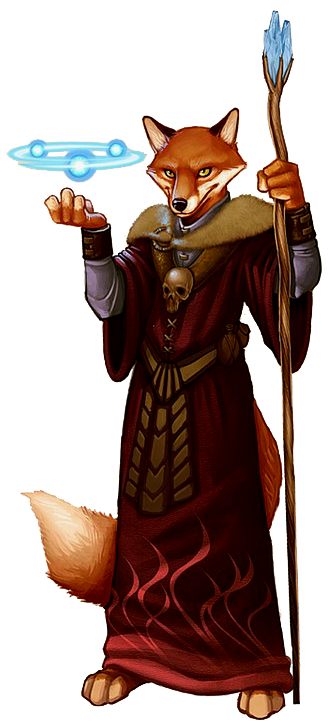
All varieties have elongated bodies with relatively short limbs, long and bushy tails, forepaws with five small fingers, furred pointy ears, and narrow and elongated skulls. Most have amber-colored eyes, although sea grey and blue eyes are not uncommon. Vulpine are thin and agile creatures, are usually three and half to four feet tall, and weigh between 25 and 40 pounds.
Although vulpine do not consider clothing necessary, many of them enjoy wearing clothes anyway for decorative purposes. The amount of clothing may vary by climate, as in hotter areas it may cause them to overheat. Even in such cases, vulpine are fond of multiple necklaces, bracelets, sashes, belts, and other accessories.
Present Over Past
Unlike the various myths of the ursine, vulpine rarely give much thought to where they came from, thinking it much more productive to spend their energies on the present than the past. That has not stopped members of the academia from theorizing, of course, but as the vulpine have not maintained any written or oral traditions regarding the matter, their veracity is dubious at best.
Whether the race was created, elevated from simple foxes, born of a mystical union, or “maybe just barfed from a magical fire” (as they commonly joke), members of the race have managed to leave their own mark on society. Vulpine have been famous thieves, musicians, magicians, rangers, warriors, and more, as the paragons among them seem to burn fast but blazingly bright.
Fame Seekers
Vulpine pregnancy lasts only two months, and kits reach adulthood after only six years. Combined with their brief lifespans, this rapid life cycle tends to instill in vulpine an urgency that many other races lack. They are eager to learn, eager to accomplish things, eager to find fame and fortune. This headlong and rapid pursuit of their goals, however, tends to make them impetuous and even reckless in the eyes of others.
Early adulthood also means that vulpine are very focused on their own individual independence and objectives. While parents are very protective of their young, once they are grown, the tendency is to push them out into the world and let them deal with life on their own. Family are not forgotten, but neither do they hold any strong allegiance among vulpine. Collectivist cultures or races seem odd to vulpine, who often don’t understand how the whole can be successful if the individual is held back or unhappy.
Nonetheless, vulpine are extremely adaptable and easily adopt the customs and dress of a given region. Even if they find themselves disagreeing with certain ways, they have an uncanny ability to fit in wherever they go.
Vulpine Names
Names among vulpine are a fluid thing, at least until one is able to gain a reputation for something. Parents give names to their kits, of course, but those names are often changed as they grow and begin to establish their own identities. A vulpine might change their name four or five times before settling on something. A final decision is usually prompted by achieving something remarkable or gaining a reputation for a particular skill or trait — this means that they might be remembered, and any fame they gain needs to be attached to a single name for maximum impact in the history books.
The actual names vary drastically by culture and nation, and might be nearly anything. Given the vulpine tendency to choose new names and seek glory, however, these names often have a flair for the dramatic or ostentatious.
Vulpine Traits
Your vulpine character has a number of traits in common with all other vulpines.
-
Ability Score Increase. Your Luck ability score, both current and maximum, increases by 4, while your Strength ability score, both current and maximum, is reduced by 4.
-
Age. Although they are relatively short-lived, vulpine also grow and mature quickly. They are considered adults at approximately 6 years old, and usually live to be 35-40 years old.
-
Alignment. Vulpine tend to be impulsive creatures and thus lean toward chaotic alignments, but exceptions are many and varied.
-
Languages. You can speak Common.
-
Size. Vulpine are slight creatures, thin-framed and standing three and a half to four feet tall. Most weigh between 25 and 40 pounds. Your size is Small.
-
Speed. Although short, vulpine are unusually quick on their feet. Your base speed is 30 ft.
-
Low-light Vision. Vulpine are comfortable in dark environments, having superior vision. You can see in dim light as if it were bright light, and an additional 60 ft into darkness as if it were dim light.
-
Mask of the Wild. You can attempt to hide even when you are only lightly obscured by foliage, heavy rain, falling snow, mist, and other natural phenomena.
-
Small Stature. Even though you might not be so strong, your body weight is low. You may use your Dexterity instead of Strength for Physical checks when your body weight is the only factor, e.g. climbing.
-
Wily. Add the Speechcraft and Stealth skills to your class skills if not already there and gain 1 skill point to spent on each of those skills.
Subtype. There are three closely related types of vulpine: arctic vulpine, grey vulpine, and red vulpine. Choose one of these subraces.
Arctic Vulpine
As an arctic vulpine, you are particularly well-suited to life in cold regions, and are tougher than others of your race in order to survive harsh winters. Most arctic vulpine have a fur coat of pure white, although some are mottled or striped with other colors.
-
Ability Score Increase. Your Constitution ability score, both current and maximum, increases by 2.
-
Ice Born. You’re naturally adapted to cold climates, as described in chapter 5 of the Dungeon Master’s Guide, and you have resistance to cold damage.
-
Alpine Camouflage. Your white fur allows you to excel at remaining hidden in certain environments. The Stealth - Arctic skill costs 0 for you.
Grey Vulpine
As a grey vulpine (also called ashfoxes), you are swift with your hands, and also very clever. Grey vulpine naturally possess grey fur, although with lighter silver or white areas on their bellies, throats, and lower jaws. Justly or not, they have a vague reputation of propensity toward thievery, which some work to overcome while others embrace.
-
Ability Score Increase. Your Intelligence ability score, both current and maximum, increases by 2.
-
Vulpine Nimbleness. You can move through the space of any creature that is of a size larger than yours.
-
Artisan. Grey vulpine are quite swift with their fingers. Add the Sleight of hand skill to your class skills if not already there and gain 1 skill point to spent on that skill.
Red Vulpine
As a red vulpine, you have an innate charm and way with others…even if that way involves a bit of a magical nudge. Red vulpine have bright orangish-red fur, with white areas on their bellies, throats, and lower jaws. With a reputation for flamboyance, winning smiles, and witty banter, red vulpine make excellent bards, sorcerers, and con artists.
-
Ability Score Increase. Your Charisma ability score, both current and maximum, increases by 2.
-
Unnaturally Charming. While communicating with a non-hostile humanoid, you can choose to have advantage on Charisma checks directed at it. If you fail the check, the creature realizes that some kind of magic was used to influence its mood and becomes unfriendly toward you. A creature prone to violence might even attack you, depending on the nature of the interaction.
Vulpine Class Options
A Vulpine approaches some classes is a bit different than other races. When you select one of these classes, it is modified as described below, as well as described in the general Beastfolk class option chapter.
-
Bard
A rare few vulpines are born with more than one tail, a sure sign of a life touched by the gods. Those Vulpine are called Kitsune. If you choose to be one, you may exchange one of your spells known with the following trait:
Ethereal Jaunt
As a bonus action, you can enter the ethereal plane, and take the Dash action when you do. You can remain in the ethereal plane until the end of your next turn. Once you use this trait, you can’t use it again until you finish a short rest.
-
Cavalier
Vulpine use mounts just as humans, but due to their smaller size they mostly use mules, goats and sometimes ponies.
-
Sorcerer
A Vulpine sorcerer has the same options as the bard.
-
Swashbuckler
A Vulpine swashbuckler can spend a panche to reroll a Luck check, even if already rerolled once, and regains a panache whenever they critically succeed at a Luck check.
Frogfolk - Bullywug
Frogfolk come in two distinct species, the swamp-dwelling Bullywug, more akin to toads, and Grung, who are smaller, froglike and adapted to a life in tropical forests.
Through only their own initiative, Bullywugs claim to be the rulers of any and all swampy regions. While they don’t have a complex social structure, most of them certainly act as if they were part of one; giving themselves extravagant titles, excessively bowing and pleading for the acknowledgement of those above them.
Bullywugs live in primitive groups, hunting and fishing together. The hierarchy is based on strength, with the strongest being the leaders. Bullywugs are very territorial, and mostly will attack anyone who trespasses. Oddly enough, they tend not to fight within the tribe, but rival bullywug tribes will fight with each other.
Bullywugs rarely work alongside other creatures since they would rather use them for food or sacrifice. However, occasionally during hard times small groups of bullywugs will latch onto a powerful ally that can help them bring down tougher game.
Bullywugs possess a unique ability to communicate with all manor of frog and toad-like creature, even over vast distances. Croaking in this manner can allow for information such as intruders, a cache of resources, or a previously undiscovered plot of land to expand upon to be quickly spread across a tribe’s area of influence.
Bullywug Traits
-
Ability Scores. Your Intelligence ability score, both current and maximum, decreases by 2.
-
Age. Bullywugs mature at 10 years, and live up to 50 years.
-
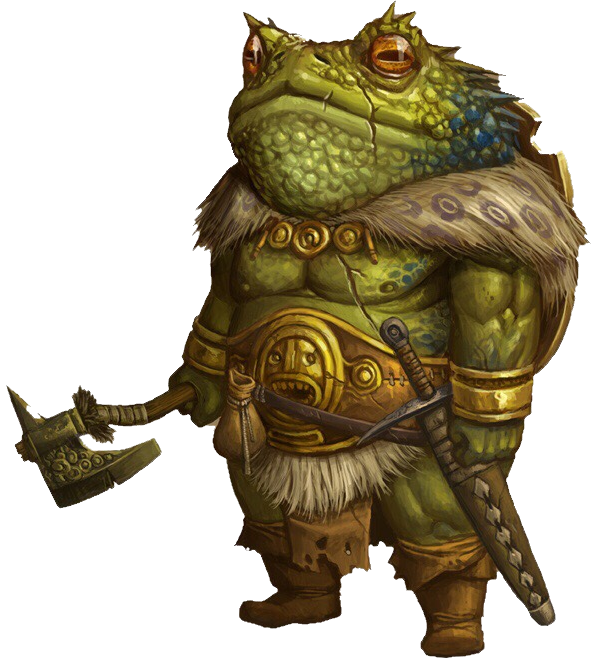
-
Alignment. Many bullywugs can be ruthless and cruel which lends them to Evil. Their indifference toward law or chaos brings them closer to Neutral on that axis. The most “outspoken” of their kind fit this trend, but a noticeable amount of tribes closer to civilization’s borders are less likely to be evil.
-
Languages. You speak Common and Bullywug. The Bullywug language is that of frogs and toads, and consists of croaks, gurgles, and obnoxious screeches.
-
Size. Bullywugs stand between 4 and 7 ft tall and weigh anywhere from 100 to 300 pounds. Your size is Medium.
-
Speed. Your base walking is 30 ft and you have a swimming speed of 30 ft.
-
Amphibious. You can breathe both air and water.
-
Bite. Your froggish maw is a natural weapon. On a hit, you deal piercing damage equal to 1d4 + your Strength modifier.
-
Bullywug Metabolism. You have advantage on saving throws against poison and resistance against poison damage.
-
One with the Swamp. The Stealth - Wetland skill costs 0 to you. You also ignore difficult terrain caused by mud and other swampy elements.
-
Speak with Frogs and Toads. You can communicate simple concepts to frogs and toads, as well as their giant counterparts and any other frog-like creatures when you speak in Bullywug.
-
Standing Leap. Your long jump is 30 ft and your high jump is 15 ft, with or without a running start.
Bullywug Class Options
Bullywug approaches some classes is a bit different than other races. When you select one of these classes, it is modified as described below, as well as described in the general Beastfolk class option chapter.
-
Bard
The croaking of the bullywug sound obnoxious, but its sound carries long distances. When casting a bard spell or using a bardic class ability, you can choose to “sing” it loudly. The range is doubled, but the sound will be heard a mile away.
-
Cavalier
Bullywug commonly ride giant toads.
Grung
While 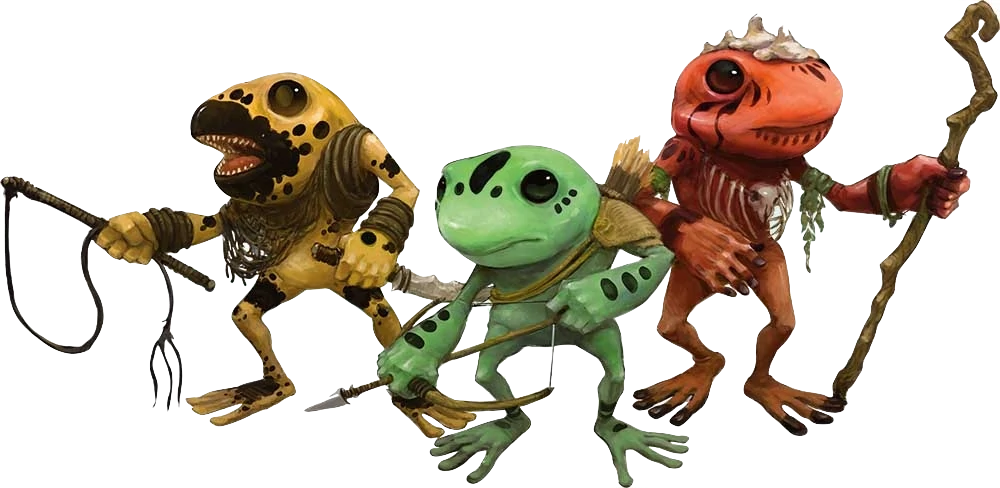 related to the swamp-dwelling bullywugs, grung are more adapted to life in rainforests and jungles. Grung tribes are often slavers, and they use their skill with poisons to keep their captives sedate by poisoning their food. Grung typically prefer their own kind, but a few ambitious grung manage to find steady work as assassins, alchemists or poisonmakers.
related to the swamp-dwelling bullywugs, grung are more adapted to life in rainforests and jungles. Grung tribes are often slavers, and they use their skill with poisons to keep their captives sedate by poisoning their food. Grung typically prefer their own kind, but a few ambitious grung manage to find steady work as assassins, alchemists or poisonmakers.
Castes and Colors
Grung society is a caste system. Each caste lays eggs in a separate hatching pool, and juvenile grungs join their caste as soon as they become physically capable. All grungs are a dull greenish gray when they are born, but the color of their caste comes to light as they mature.
Green grung become warriors, hunters, and general laborers. Blue grung are usually artisans and domestic workers. Supervising and guiding both those groups are the purple grungs, which serve as administrators and commanders. Red grung are born with magical talent, and often serve as advisors to those in positions of true leadership. Orange grung are a tribe’s elite warriors, with authority over all lesser grungs.
Grung Traits
-
Ability Score Increase. Your Strength ability score, both current and maximum, is reduced by 4. In addition you increase one ability score by 1, depending on your caste as shown in the color/caste table.
-
Age. Grungs reach maturity 2 years after they hatch and they live up to 30 years.
-
Alignment. Most grungs are lawful, having been raised in a strict caste system. They tend toward evil as well, coming from a culture where social advancement occurs rarely, and most often because another member of your army has died and there is no one else of that caste to fill the vacancy. Exceptions do exist, but are only found in tribes that neighbor friendlier civilizations.
-
Languages. You can speak Common and Grung.
-
Size. Grung are between 3 and 4 ft tall, and weigh 30-50 pounds. Your size is Small.
-
Speed. Your base walking is 25 ft. You also have a climbing speed of 20 ft.
-
Amphibious. You can breathe air and water. However, you must submerge yourself fully in water or mud once per day or suffer one level of exhaustion, which cannot be removed until you complete a long rest while submerged.
-
Grung Resilience. You have advantage on saving throws against poison and resistance against poison damage.
-
Poisonous Skin. When not wearing heavy armor, any creature that grapples you or otherwise becomes in direct contact with your skin must make a Constitution saving throw or be poisoned for 1 minute. If the creature is no longer in contact with your skin, they may repeat the saving throw at the end of each of their turns. A creature that has successfully saved against your poison is immune until it has finished a longrest. The DC for this saving throw is 8 + your Constitution modifier + your proficiency bonus.
-
Poisoned Weapons. The Alchemy - Prepare poisons skill costs 0 to you. As a ritual, you can create a single dose of your own skin’s poison, which can be applied to a weapon. The applied poison lasts for 1 hour or until the weapon strikes a creature, which makes a saving throw as if it had touched your Poisonous Skin.
-
Small Stature. Even though you might not be so strong, your body weight is low. You may use your Dexterity instead of Strength for physical checks when your body weight is the only factor, e.g. climbing.
-
Standing Leap. Your long jump is 20 ft and your high jump is 15 ft, with or without a running start.
-
Sticky Pads. If you have both hands free, you can climb freely across smooth, vertical, and upside down surfaces. While you climb in this way, you cannot make attacks that require your hands or perform spells that require somatic components.
Grung tables
When creating your grung, roll on the color/caste table once, and on the other tables as you wish for inspiration.
-
Color / Caste
d6 Your color/caste is… Ability score 1 an unusual color (outcast) or multi-hued Any one 2 green (warrior/hunter/laborer) Dexterity 3 blue (artisan/domestic) Charisma 4 purple (administrator) Wisdom 5 orange (elite warrior) Strength and Constitution 6 red (scholar/magic user) Intelligence -
Individual Treasure
d8 You have a… 1 clay urn full of fireflies. 2 net & harpoon with leash tether. 3 giant snake jawbone helmet. 4 doll of a frog eating an adventurer. 5 pouch of roasted yahcha beetles. 6 pouch of 4d6 silver pieces. 7 shiny shell. 8 ornamental “armor” made from (d6): 1. bronze 2. bone 3. ferns 4. fishing net 5. giant snail shell 6. seashells -
Mannerism
d8 You… 1 believe anything gold is good and to be respected. 2 click when agitated. 3 have skin that slightly changes pallor to reflect your mood, what you last ate, or your environment. 4 constantly check if others have urinated on their eggs today. 5 expect other races to understand all the nuances of grung whistles. 6 are gluttonous and cast wantonly lustful looks at others’ food. 7 engage in a stare-off with almost any living creature. 8 inadvertently make awful frog-related puns. -
Goal
d8 You are looking for… 1 waters for soaking, fishing, and foraging. 2 new slaves. 3 a mate. 4 trees and plants for building. 5 medicinal herbs. 6 insects to trap or harvest. 7 the secret to change your coloration. 8 eggs stolen from your home. -
Catch Phrases
d8 You are fond of saying… 1 “Keep a tongue out for danger.” 2 “Long live the Supreme Leader!” 3 “For glory and tribal advancement!” 4 “Holy cloaca!” 5 “The bigger they are, the harder they fall.” 6 “I don’t do things. I have people who do things. That’s good management.” 7 “You’re not even color-coded!” 8 “Trust in the order of the Tribe. Let us uplift deeply held national belief.” -
Water Dependency
d6 You deal with water dependency by… 1 collecting scrolls of create water… which you usually read correctly. 2 harvesting plants that store water. 3 never going too far from your known watering hole(s). 4 relying on rain forecasting rituals, and restricting travel to rain days. 5 setting up fog catchment tarps throughout your territory. 6 traveling with a rain-catcher and dozens of waterskins (carried by slaves or pack animals). -
Quirks
d6 You… 1 suffer madness (DMG 260). 2 sleep best while submerged in water. 3 have a hard time controlling your tongue. It occasionally snatches food that doesn’t belong to you. 4 accidentally pick up stray objects due to its slimy skin. 5 have no personal hygiene. 6 store spare items in your mouth. -
Grung Names
d20 Name 1 Bleep 2 B’gulp 3 Chiirr 4 Chm’chmny 5 Erg 6 Floorp 7 Guoguo 8 Jr’myeh 9 Ker’plop 10 K’ung F’huu 11 Lik’iti 12 Ouro 13 Pbaht 14 Quon 15 Riki’tiki 16 Snurk 17 Sook’it 18 Squoggle 19 Vwaak 20 Woog Woog -
Strategy
d6 You prefer to attack with… 1 overwhelming numbers. 2 elaborate formations with silly names. 3 threats, decoys, and readied attacks. 4 camouflaged guerilla warfare. 5 a quick calculated raid. 6 poisonous grappling in pairs while bungee-jumping from trees. -
Slaves & Servitors
d12 You are served by… 1 nothing and no one. 2 what you believe is an unseen servant. 3 a grung toadie of a lesser caste. 4 a giant frog mount (with poison immunity). 5 1d6 tribal warriors or scouts in a drugged/delirious state. 6 1d6 goblins in a drugged/delirious state. 7 a thug who traded for grung poison. 8 a mad druid. 9 a veteran in a drugged/delirious state. 10 an ogre or troll in a drugged/delirious state. 11 a mage in a drugged/delirious state…or is he/she? 12 DM’s choice.
Grung Class Options
Grung approaches some classes is a bit different than other races. When you select one of these classes, it is modified as described below, as well as described in the general Beastfolk class option chapter.
-
Alchemist
Grung have a penchant for alchemy and are usually quite good at it. However, the oils constantly secreted from their skin usually mixes up with everything. Whenever a target is damaged (or, unfortunately, healed) by any of your concoctions, they are also affected by your poisonous skin. You are of course immune to this.
Whenever the Alchemist class description mentions your Intelligence modifier, you may instead use this modifier +4 or your proficiency bonus, whichever is lower.
-
Cavalier
Grung commonly ride giant frogs.
Varkind
Varkind appear to be large humanoid pigs. Most have big bellies with swarthy, stout bodies and possess long stout arms, ending in hands with 3 cloven fingers and a thumb, while standing on short but powerful legs. They have large, squat faces, small beady eyes, floppy ears and pronounced snouts. The females tend to have smaller, more petite snouts, and rounder bodies. Favoring both utility and style, the varkind tend to wear heavy enduring clothing such as jackets, suits, and boots, favoring ornate and finely made pins and medals as a form of decoration. Females tend to wear some form of bonnet or hat, elaborately decorated with feathers or pins, and favor dresses and coats with careful and neat embroidery.
There are two main types of varkind, very much shaped from the environment they live in. Urban varkind tend to look like domestic pigs, with tufted ears and larger snouts. They are famously happy-go-lucky, with sunshine laden, easy going personalities. Barbarian tribes of varkind tend to have a more boar-like appearance, with thick fur or a crested mane, and the males tend to have large tusks protruding from their faces, which they ornately decorate or trim.
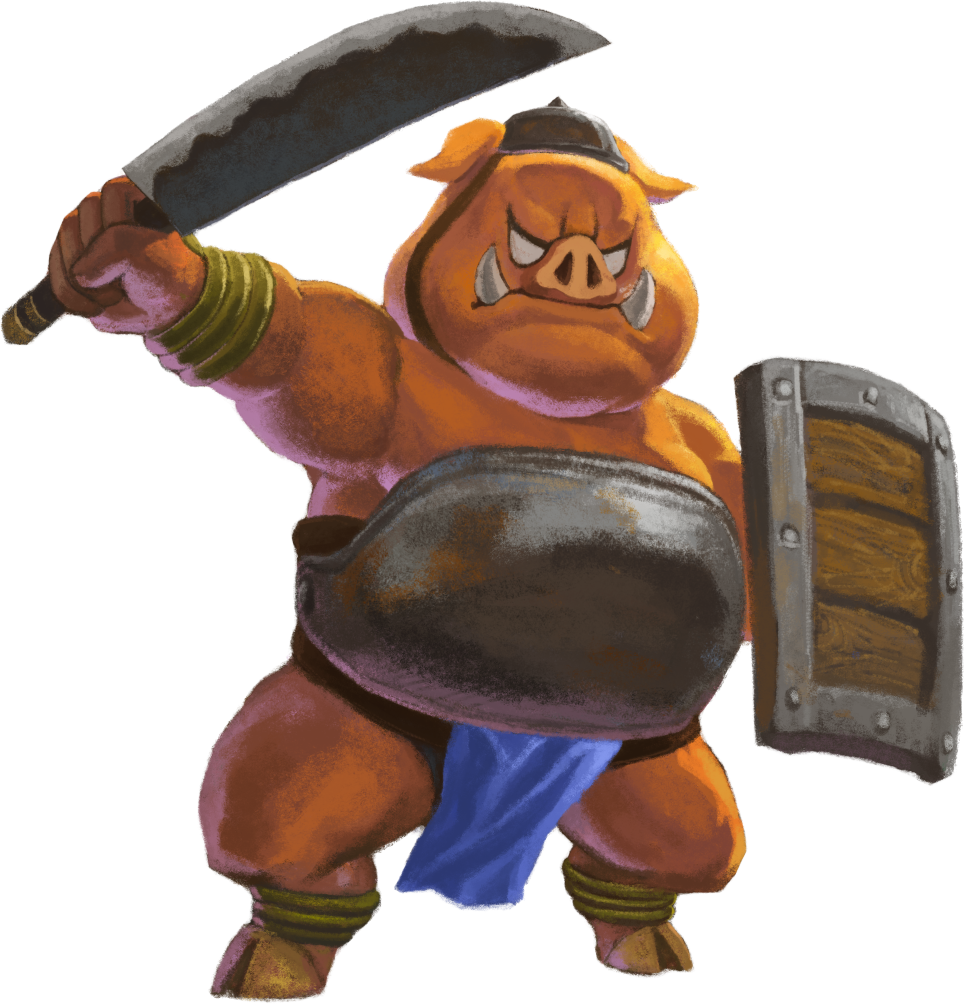
“Giggling and snarling to herself, Pack Lord Gnara smiled, listening to the faint squealing and snorting she heard coming from the shield wall, she eagerly charged forward, trampling the smaller gnolls in her bloodlust, only to stop abruptly, as the shield wall parted to reveal a sea of shining tusks, with crossbows pointed at her and her kin, fear coursed through her for the first time, replacing her hot bloodlust with cold fear, as she felt scores of beady eyes lock on to her.”
– Final Battle of Wolfroot Vale
Varkind never forget favor nor offense: they are patient and kind with friends and loved ones, and vicious and unforgiving toward their enemies or those who have done them wrong. They are known to hold a grudge for the entirety of their lives.
Society
Varkind communities, or Sounders, are often made up of several large families, each family sometimes consisting of almost half a hundred individuals. Each Sounder is lead by a small council of elders or experienced leaders, deciding everything from community defenses to where the herdsmen will send their flocks, or even when and where to farm. A quiet and often reserved people, the varkind are renowned farmers, breeders, and very shockingly as mercenaries. The varkind are surprisingly adept hunters, mastering the use of crossbows so well, that they have only one type of organized military, armored varkind called “Iron Tusks”, all trained in the extensive use of crossbows and heavy shields.
The life of an adventurer appeals to many young varkind and is something actively encouraged by their parents, many of whom thought a few years spent on the road would do the young blood well, burning the curiosity and restlessness out of their systems. Many would eventually return home for good, but others still would manage to settle down and establish businesses, or even Sounders in different parts of the world. Many famous inns are varkind owned and managed, and often catered almost exclusively to adventurers.
Varkind Names
Varkind names are all hereditary, passing down the family line for centuries. Sons and daughters take on the names of their parents, and pass them to their children, and so on. Examples of this might be Eckhart the 39th, or Maja the 85th. The higher the number indicated a family that was very well off, and had been around for a very long time.
Male: Anton, Armin, Bastian, Benedikt, Dieter, Eckhart, Gerhard, Horst, Joachim, Marwyn, Weiland
Female: Ada, Agatha, Bertha, Caroline, Franka, Heidi, Irma, Kiki, Lulu, Marta, Maja, Sofi, Thora
Varkind racial traits
Your varkind character has the following racial traits.
-
Ability Score Increase. The varkind are far more durable than most, taking pride in their stocky shape and ability to face physical hardship. Your Constitution score, both current and maximum, increases by 2.
-
Age. Varkind mature at the same rate as humans, yet live much longer, often two or three centuries.
-
Alignment. Possessed of a kind and generous nature, varkind are often neutral good, taking care of those in need, yet never truly taking sides in most conflicts, choosing to remain uninvolved until absolutely necessary.
-
Size. Varkind are as stout as dwarves, standing between 4 and 5½ ft tall, and weighing 100-200 pounds. Your size is Medium.
-
Languages. You know Common and Varkind.
-
Speed. Their bulky stature and awkward frame slightly hampers them. You have a movement speed of 25 ft. However, your speed is not reduced by wearing heavy armor.
-
Invincible Stomach. You have advantage on saving throws against indigestible poisons, as well as other effects caused by consumed items or goods.
-
Mud Lover. Difficult terrain due to mud does not impede your movement.
-
Sure Footed. Your low center of gravity makes it difficult to knock you over. You have advantage on saving throws you make to avoid being knocked prone.
-
Thunderous Squeal. As a bonus action, you can release a loud squeal. It is audible at 500 ft, and creatures within 10 ft of you that can hear you must succeed a Constitution saving throw DC 8 + your proficiency bonus + your Constitution modifier, or take your level in thunder damage. You can use this ability once, and regain use of it when you finish a long rest.
Subtype. There are two main subraces of varkind, the urban variant and the tribal boarlike subtype.
Urban
Slightly smaller and decidedly rounder than their more rustic cousins, the urban varkind make up for their lack of physical abilities with a razor sharp mind and jovial ways, making wonderful tradesmen, and merchants, as well as brilliant strategists.
-
Buffet Enthusiast. After a meal where you consume twice as much food as what’s normal for you during a rest, you also gain an amount of temporary hit points equal to 1d6 + your Constitution modifier. This increases by +1d6 at 6th, 12th and 18th level.
These temporary hit points stack with other sources of temporary hit points granted by food. Once you benefit from this trait, you can’t benefit from it again until you finish a long rest.
-
Open Minded. The Perception - Insight skill costs 0 to you.
Tribal
This larger, more boarlike subrace, live a barbaric lifestyle in smaller tribes. They have tusks and a dark skin covered with thick hair.
-
Endurance. When you are dropped to 0 hp or less, you may use your reaction to go back to 1 hp. You regain the use of this ability after taking a long rest.
-
Tusks. With their deadly tusks, they’re capable of impaling all in their way. They are natural weapons dealing 1d4 + your Strength modifier slashing damage. This base damage increases to 1d6 at 6th level, 1d8 at 12th level, and 1d10 at 18th level. You may also use this attack as an “off-hand” attack as a bonus action.
Varkind Class Options
Varkind approaches some classes is a bit different than other races. When you select one of these classes, it is modified as described below, as well as described in the general Beastfolk class option chapter.
-
Alchemist
Urban Varkind are masters of Molecular gastronomy. Their life often revolves around food, and varkind alchemists often combine alchemy with food. If you multiclass as a professional (cook), you can count some of your professional class levels as being alchemist levels in regards to your alchemist class features (applies to concoctions and brew potions). You can count max number of levels equal to your alchemist level.
Tribal Varkind. The invincible stomach of this race causes the bombs and poison concoctions of the tribal varkind alchemist not to be deadly to ingest for them. In fact, even though they taste terrible, they can function as potion concoction when drunk by the alchemist.
-
Cavalier
Varkind are not a very graceful people. They usually avoid riding, instead prefering to ride in a chariat or cart. As a varkind cavalier you can use a mount-drawn chariot instead of a steed.
-
Professional
Not surprisingly, the varkind make very good professionals, especially cooks.
Whenever the professional class description mentions your Wisdom modifier, you can use your proficiency bonus instead.
Also, for urban varkind see the alchemist class option.
Kunek
Kunek are small humanoids with short fur, and the heads, tails and feet of rabbits. Their powerful limbs make them capable of remarkable leaps. They have long, sensitive ears and their eyesight detects motion almost reflexively. Their eyes are placed on the sides of their heads, akin to true hares and rabbits, giving them almost complete 360-degree vision. Kunek from northern climes have white fur, while those from southern areas will have fur of a darker color.
They are taller than halflings, standing a bit less than three and a half feet tall, but a little more lanky, weighing about 35 lbs. Kunek like lavish clothing with earthy tones for colors, preferring whites, greens, and brown hues over reds and purples. They have a preference for robes and coats, as well as long sleeve shirts, preferring the comfort they bring.
They are careful, intentional and cautious beings, but make excellent and loyal friends to those they come to know and love. Kunek are naturally drawn to people, and very social, but prefer to have a few feet of personal space and do not like to be touched or jostled by strangers. Kunek will go to great lengths to avoid a crowd.
Kunek are kind and caring, placing a great deal of stock in performing good deeds, but the expectation of reward is not something that enters their minds. Other races think of them as flighty busybodies because of their predilection to take on more than one task at a time, but they have short lives and only so long to accomplish their goals.
They regularly have as many as five children at once. Their infants are tiny and helpless for about a year, but quickly grow and reach adulthood in just a few short years, mastering language and their bodies at an incredible rate.
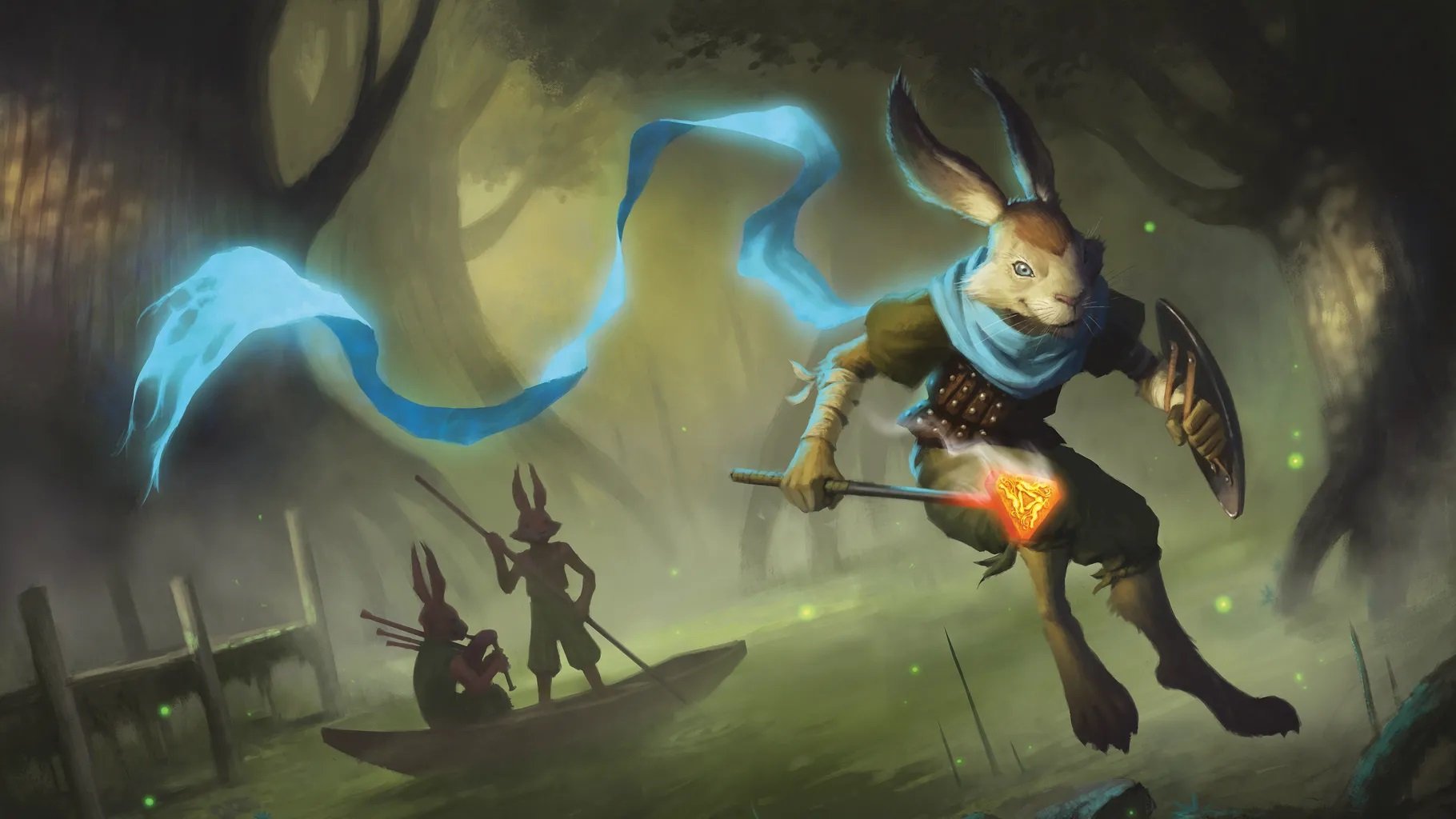
Warrens
Kunek life is centered on warrens, independent communities of kunek usually made up of multiple families with complex interwoven bloodlines. Like traditional halfling homes, warrens are built partially underground, often beneath low hills or downs. Unlike halfling villages, however, kunek communities are interconnected below ground, often creating a bewildering maze of tunnels and passageways.
In most warrens, public spaces are entirely underground, and there may be as few as two exits to the outside world. In wealthier warrens, it is more common for individual domiciles to have their own entrances/exits, windows, etc. More secretive warrens may disguise or even booby-trap their entrances.
Kunek society is highly rigid and structured, with a hierarchical collective leadership. Each warren is led by a council of elders, at the head of which is a chief. Chiefs append the honorific -rah (roughly translated as “prince” or “leader”) to their names. The role of chief varies from benign figurehead to military dictator, but most warrens prefer a more consultative, quasi-democratic approach.
Although kunek are not aggressive by nature, they will fiercely defend their warrens against attack and have occasionally even been known to go to war with neighboring warrens.
Religion
The kunek religion characterizes the sun as Frith, a benign creator-god. The moon is Inlé, a land of darkness and the realm of the Black Rabbit of Inlé, the god of death.
But by far the most important figure in the kunek pantheon is El-ahrairah, the Prince with a Thousand Enemies, a trickster god who favors the form of a rabbit, and who is considered the ancestor of the kunek race. Their religion prizes wisdom, cunning and caution as virtues, believing if one uses their gifts to the utmost, they will leave a lasting legacy upon the world in the form of friendships and children that will echo throughout the ages.
Kunek Names
Kunek have two names. Their first name is usually taken from human or halfling cultures in their geographical areas, whilst their family names take inspiration from the environment and the deeds of their ancestors—their family names are fluid and prone to change every few generations, whether from changing reputations, a new deed, or settling in a new area.
Male: Blackavar, Buck, Celandine, Charlock, Chervil, Hawkbit, Hrairoo, Laburnum, Nightshade, Orchis, Sainfoin, Scabious, Speedwell, Thlayli, Threar, Vervain
Female: Anflellen, Betony, Clover, Flyarth, Hynthlay, Nethilta, Nilhain, Nyreem, Thrayonlosa, Vilthuril, Violet
Family names: Brookbounder, Dawnwild, Lakechaser, Thicketquick, Trickpaw
Kunek racial traits
Your kunek character has the following racial traits.
-
Ability Score Increase. Your Luck ability score, both current and maximum, increases by 2, while your Strength ability score, both current and maximum, is reduced by 4.
-

-
Age. Kunek mature at 5 years, and live up to 30 years.
-
Alignment. Kunek tend to be warm, polite, and kind, following a commonly good alignment. They are known for having a strong conscience and harbor little ill will towards others, and are just as likely to be lawful as chaotic.
-
Languages. You know Common and Kunek.
-
Size. Kunek are between 3 and 4 ft tall, and weigh an average of 35 pounds. Your size is Small.
-
Speed. You have a movement speed of 30 ft.
-
Low-light Vision. Accustomed to life in the warren, you can see in dim light as if it were bright light, and an additional 60 ft into darkness as if it were dim light.
-
Keen Senses. You have advantage on Perception checks that rely on hearing. In addition, you may add your proficiency bonus to initiative checks.
-
Nimble Hop. Your long jump is up to 20 ft and your high jump is up to 10 ft, with or without a running start, and you can use your Dexterity score in place of your Strength score in regards to jumping.
-
Obligate Vegetarian. Kunek cannot eat meat. If you do so you must make a DC 15 Constitution saving throw or be poisoned until you take a long rest.
-
Rabbit’s Foot. As a reaction, when a hostile creature moves adjacent to you, you can take the Dodge action and may move up to half your speed without provoking opportunity attacks. You can do this a number of times equal to you Luck ability modifier, and you regain the uses after you finish a long rest.
-
Small Stature. Even though you might not be so strong, your body weight is low. You may use your Dexterity instead of Strength for physical checks when your body weight is the only factor, e.g. climbing.
Kunek Class Options
Kunek approaches some classes is a bit different than other races. When you select one of these classes, it is modified as described below, as well as described in the general Beastfolk class option chapter.
-
Bard
Kunek has a unique way of performing music. They use their feet and stomp the rythm. This allows them to sing and play without needing an instrument.
-
Cavalier
Kunek prefer not to be mounted, instead choosing to walk or ride a comfortable cart.
-
Fighter
At 1st level, you can add the Tunnel Fighter and Close Quarter Shooter styles to your selection of fighting styles.
Tunnel Fighter
You excel at defending narrow passages, doorways, and other tight spaces. As a bonus action, you can enter a defensive stance that lasts until the start of your next turn.
While in your defensive stance, you can make opportunity attacks without using your reaction, and you can use your reaction to make a melee attack against a creature that moves more than 5 ft while within your reach.
Close Quarters Shooter
You are trained in making ranged attacks at close quarters. When making a ranged attack while adjacent to a hostile creature, you do not have disadvantage on the attack roll. Your ranged attacks ignore half cover and three-quarters cover against targets within 30 ft of you. Finally, you have a +1 bonus to attack rolls on ranged attacks.
-
Paladin
A kunek paladin of 2nd level can choose the Tunnel Fighter fighting style instead of the ones in the class listing (see the fighter entry above).
-
Ranger
A kunek ranger of 2nd level can choose the Close Quarters Shooter fighting style instead of the ones in the class listing (see the fighter entry above).
-
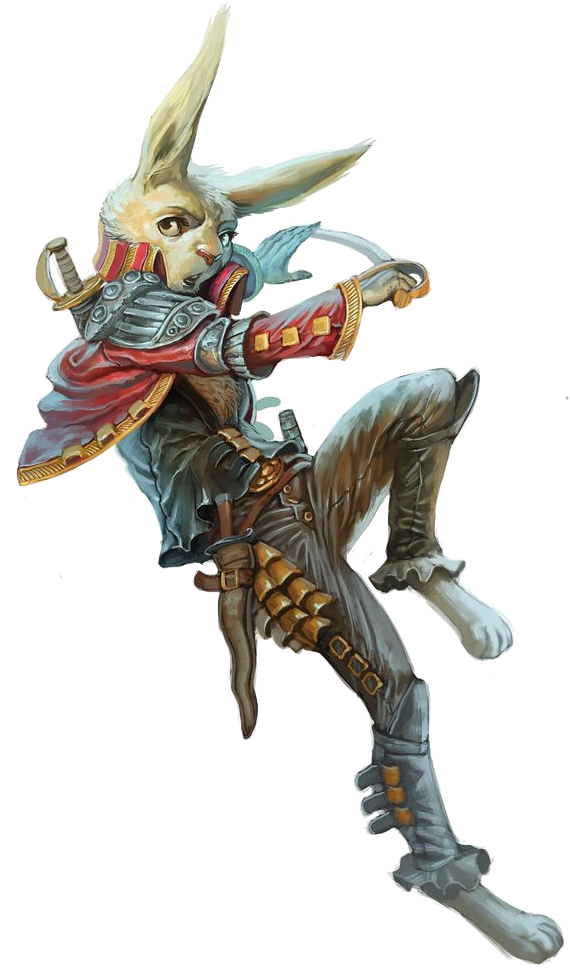
Ratfolk
Ratfolk are small, rodent-like humanoids; originally native to subterranean areas in dry deserts and plains, they are now more often found in nomadic trading caravans. Much like the pack rats they resemble, ratfolk are tinkerers and hoarders by nature, and as a whole are masters of commerce, especially when it comes to acquiring and repairing mechanical or magical devices. Though some are shrewd merchants who carefully navigate the shifting alliances of black markets and bazaars, many ratfolk love their stockpiles of interesting items far more than money, and would rather trade for more such prizes to add to their hoards over mere coins. It’s common to see a successful crew of ratfolk traders rolling out of town with an even larger bundle than they entered with, the whole mess piled precariously high on a cart drawn by giant rats.
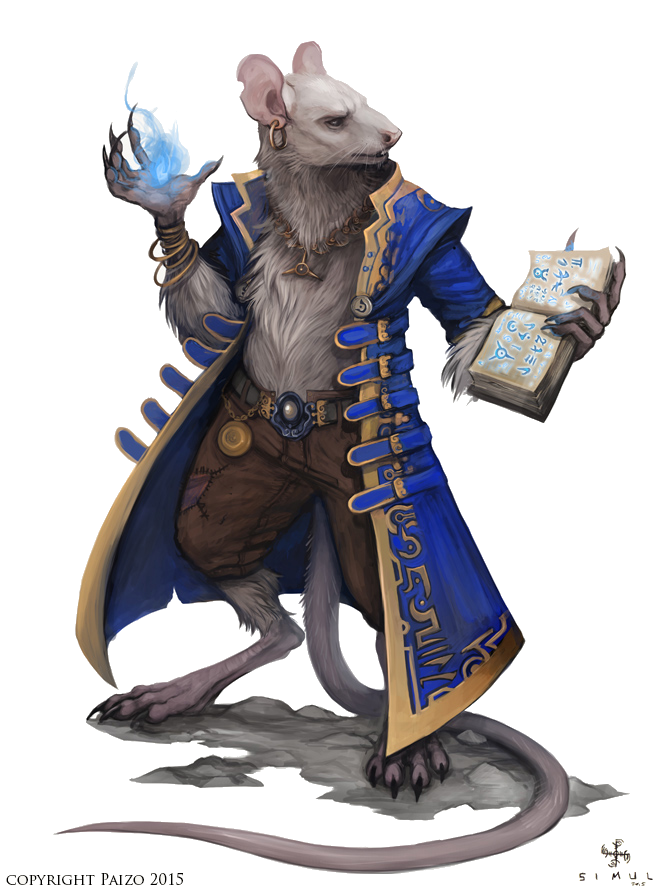
Physical Description
Most ratfolk stand slightly shorter than men, no more than four or five feet tall and slightly built. Fur covers their entire bodies, and their fingers and toes end in small, sharp talons. Their fur colors range widely, from the rare shades of black or white to the vastly more common reddish brown. their incisors extend below their jaw and can cut through wood and flesh with equal ease. Ratfolk eyes are small and red, and reflect light well. In addition, they possess sharp hearing and a keen sense of smell. They often wear robes to conceal their forms in cities, as they know other humanoids find their rodent features distasteful.
Ratfolk have a strong attraction to shiny jewelry, especially copper, bronze, and gold, and many decorate their ears and tails with small rings made of such metals. They are known to train giant rats, which they often use as pack animals and mounts.
Random Height and Weight
| Gender | Base Height | Height Modifier | Base Weight | Weight Modifier |
|---|---|---|---|---|
| Male | 100 cm | +5d4 | 30 kg | +5d4 × (Strength/10) |
| Female | 90 cm | +5d4 | 25 kg | +5d4 × (Strength/10) |
Society
Ratfolk are extremely communal, and live in large warrens with plenty of hidden crannies in which to stash their hoards or flee in times of danger, gravitating toward subterranean tunnels or tightly packed tenements in city slums. They feel an intense bond with their large families and kin networks, as well as with ordinary rodents of all sorts, living in chaotic harmony and fighting fiercely to defend each other when threatened. They are quick to use their stockpiles of gear in combat, but prefer to work out differences and settle disputes with mutually beneficial trades.
When a specific ratfolk warren grows overcrowded and the surrounding environment won’t support a larger community, young ratfolk instinctively seek out new places in which to dwell. If a large enough group of ratfolk immigrants all settle down in a new, fertile area, they may create a new warren, often with strong political ties to their original homeland. Otherwise, individual ratfolk are inclined to simply leave home and take up residence elsewhere, or wander on caravan trips that last most of the year, reducing the pressure of overcrowding at home.
Alignment and Religion
Ratfolk individuals are driven by a desire to acquire interesting items and a compulsion to tinker with complex objects. The strong ties of ratfolk communities give them an appreciation for the benefits of an orderly society, even if they are willing to bend those rules when excited about accomplishing their individual goals. Ratfolk who take to religion tend to worship deities that represent commerce and family.
Ratfolk traits
Your ratfolk character has a number of traits in common with all other ratfolk.
-
Ability Score Increase. Ratfolk are agile and clever, but physically weak. Your Deterity ability score, both current and maximum, increases by 2, while your Strength ability score, both current and maximum, is reduced by 2.
-
Age. Ratfolk mature quicker than humans do, and most are expected to settle down to into an adult life by around age 10. They can live 30 to 40 years on average, with some very well-kept individuals going on to live 50 years.
-
Alignment. Ratfolk are free spirits and are most often Chaotic, tending to ignore rules that don’t suit their tastes. They also tend towards Good, given that they prefer social groupings and generally value communal care over selfishness.
-
Languages. You speak Common.
-
Size. Ratfolk are at the lower limit of Medium size.
-
Speed. You have a base speed of 30 ft.
-
Low-light Vision. Accustomed to life beneath the ground, you have superior vision. You can see in dim light as if it were bright light, and an additional 60 ft into darkness as if it were dim light.
-
Sneaky. Add the Stealth skill to your class skills if not already there and gain 1 skill point to spent on that skill.
Subtype. Ratfolk are split into two main types: Wild walkers and Sewer dwellers. Choose one of these.
Sewer Dweller Ratfolk
Sewer dwellers call underground network of tunnels or sewers their home, surviving however they can in the waste of others. They are typically more bitter and are often more cunning.
-
Natural Tinker. The Engineering - Tinkering skill costs 0 to you. Additionally you gain 1 skill point to spend on the Crossbow weapon group.
-
Sewer Resilience. You have advantage on saving throws to resist poison and against contracting diseases, including magical diseases.
Wild Walker Ratfolk
Wild walkers are ratfolk who hail from the far reaches of civilization. They make their homes in burrows in forests or hills.
-
Scent. The Perception - Sense-smell skill costs 0 to you. In addition you can track by scent.
-
Trailblazer. You to move an additional 5 ft when taking the dash action.
Ratfolk class options
Ratfolk approaches some classes is a bit different than other races. When you select one of these classes, it is modified as described below, as well as described in the general Beastfolk class option chapter.
-
Barbarian
Ratfolk fight viciously when cut off from friends and allies. Whenever you are reduced below half your hp, and have no conscious ally within 30 ft, reduce all damage received by 1. This stacks with other similar abilities.
In addition you have access to the Path of the Tailfighter.
-
Cavalier
Ratfolk are often seen riding giant rats.
-
Fighter
At 1st level, you can add the Tunnel Fighter and Close Quarter Shooter styles to your selection of fighting styles.
Tunnel Fighter
You excel at defending narrow passages, doorways, and other tight spaces. As a bonus action, you can enter a defensive stance that lasts until the start of your next turn.
While in your defensive stance, you can make opportunity attacks without using your reaction, and you can use your reaction to make a melee attack against a creature that moves more than 5 feet while within your reach.
Close Quarters Shooter
You are trained in making ranged attacks at close quarters. When making a ranged attack while adjacent to a hostile creature, you do not have disadvantage on the attack roll. Your ranged attacks ignore half cover and three-quarters cover against targets within 30 feet of you. Finally, you have a +1 bonus to attack rolls on ranged attacks.
-
Paladin
A ratfolk paladin of 2nd level can choose the Tunnel Fighter fighting style instead of the ones in the class listing (see the fighter entry above).
-
Ranger
A ratfolk ranger of 2nd level can choose the Close Quarters Shooter fighting style instead of the ones in the class listing (see the fighter entry above).
-
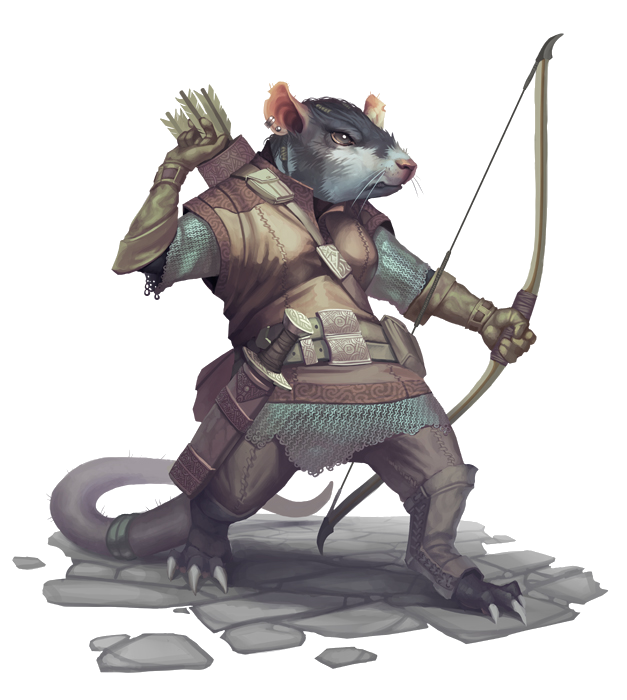
Beastfolk Class Options
There are a lot of similarities in how the different beastfolk approach character classes, and they are all summarized in this chapter. Each class will also mention if the options apply to all beastfolk of just some.
-
Alchemist
Most beastfolk never even come into contact with the alchemical crafts unless they live in or near a human city. However, those who have can usually become as good alchemists as any other race.
-
Barbarian
Raging beastfolk often give in completely to their animalistic side. If attacking only with natural weapons while raging, you can make an additional attack when you take the Attack action. You may also attack with a bonus action, as if wielding an off-hand weapon.
If you are a beastfolk without natural weapons, you can still bite, kick, rip and tear as if you had a natural weapon dealing 1d3 bludgeoning or slashing damage. You can use either your Strength or Dexterity for those attacks.
-
Bard
In human societies a beastfolk bard is usually not very sought after, as what is considered music differs a lot between human and most beastfolk. Humans generally considers beastfolk singing to be annoying noise, with the exception of kunek, who actually has excellent singing voices.
-
Cleric
Some beastfolk follow the same pantheons as their human or (in the case of kunek) halfling neighbours. Others follow a more primal patheon, represented in the cleric class document as the Celtic pantheon.
If you are a cleric following the celtic pantheon, whenever the cleric class description mentions your Wisdom modifier, you may instead use your proficiency bonus.
-
Cursed
Humans often consider the different beastfolk races to already be the victims of a curse, but you know it is not true, because you have been struck by a real curse.
Whenever the cursed class description mentions your Intelligence modifier (i.e. for spellcasting), you may instead use your proficiency bonus.
-
Druid
Beastfolk druids are more common than clerics, as these races are strongly connected to nature. The worship is often not to nature, but more to the same pantheon as the clerics.
Whenever the druid class description mentions your Wisdom modifier, you may instead use your proficiency bonus.
-
Feyblood
As a beastfolk feyblood, you can use your fairy dust to transform yourself or a willing creatures to the beast you are related to. This functions as polymorph, but lasts until the transformee ends it or becomes unconscious. If cast on yourself, you keep your mental abilities.
-
Fighter
The natural traits of beastfolk, such as thick fur or feral ways, make them fearsome fighters.
As a beastfolk fighter you may use your proficiency bonus instead of your Dexterity bonus when calculating AC and initiative.
-
Inquisitor
The religious practices of beastfolk are usually not focused on things outside their own communities, so the inquisitor role is mostly non existant. The only time you would see a beastfolk inquisitor would be if the individual grew up among humans.
-
Paladin
Paladins are embodiments of the heroic ideals for their race. As the most common race that becomes paladins are humans, the archetypical behaviour of paladins is the ideal for humans.
This often confuses people when they first meet a beastfolk paladin, as they follow the ideals of their race, which might be similar, but can also be completely different from humans.
-
Professional
Beastfolk professionals fill the same niche in their communities that professionals do in other racial communities. However, generally beastfolk tend to prefer and value the more practical fields, like the candlemaker, cook, smith or forester.
If belonging to a more practical field, whenever the Professional class description mentions your Wisdom modifier, you may instead use this modifier +3 or your proficiency bonus, whichever is lower.
-
Ranger
No humanoid race is as attuned to nature as beastfolk.
Whenever the Ranger class description mentions your Wisdom modifier, you may instead use this modifier +3 or your proficiency bonus, whichever is lower. In addition, you may use the same modifier instead of Strength or Dexterity when attacking (attack and damage). Make this choice at level 1 and it cannot be changed later.
-
Rogue
Beastfolk are by nature adept at sneaking around as they all descended from predators or prey.
As a beastfolk rogue, whenever you are in the wild and make a Dexterity ability skill check, you may use your proficiency bonus instead of your Dexterity bonus. You may not use more than half your rogue level.
-
Sorcerer
Sorcerers are just as rare and varied as within other races.
Whenever the Sorcerer class description mentions your Charisma modifier, you may instead use your proficiency bonus.
-
Swashbuckler
Beastfolk that choose to take the path of swashbuckling tend to more clever than calculating.
Whenever the Swashbuckler class description mentions your Intelligence modifier, you may instead use your proficiency bonus.
-
Warlock
Taking shortcuts to power is just as common among beastfolk as any other thinking creature.
Whenever the Warlock class description mentions your Charisma modifier, you may instead use your proficiency bonus.
-
Wizard
A beastfolk mage often use alternative ways of recording spells, like runes worn as necklaces or runcarved staffs.
Whenever the Wizard class description mentions your Intelligence modifier, you may instead use your proficiency bonus. You may only do this if you are literate.